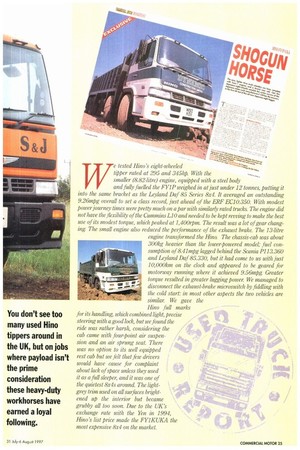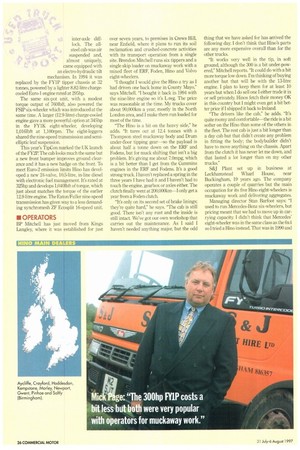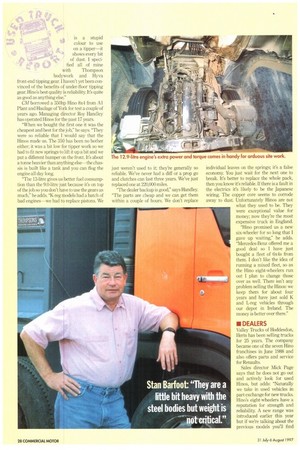• The Harris Group, based in Dublin, has maintained its
Page 26

Page 27

Page 28

Page 29

Page 30

Page 31

If you've noticed an error in this article please click here to report it so we can fix it.
connection with Japanese truck maker Hino for many years. It imports vehicles in kit form and builds them for the Irish and British markets. They drive on the left in Japan so no major modifications are needed. While best known in the West for rugged eight-leggers, Harris also assembles six-wheelers and tractive units.
• EVOLUTION
The FY275KA was the first Hino eight-wheeler to make its presence felt on the UK mainland at 30 tonnes GVW. It was inn-oduced in 1985 with a big (13,27-litre) naturally aspirated six-pot diesel rated at 243hp and driving through a 17in-diameter clutch to a six-speed box with synchro on 3rd and 6th as standard (a nine-speed constant-mesh transmission was available as an option).
Its double-drive, single-reduction bogie, rated at 20 tonnes, was equipped with an
and fully fuelled the FY1P weighed in at just under 12 tonnes, putting it into the same bracket as the Leyland Daf 85 Series 8x4. It averaged an outstanding 9.26mpg overall to set a class record, just ahead of the ERF EC10.350. With modest power journey times were pretty much on a par with similarly rated trucks. The engine did not have the flexibility of the Cummins L10 and needed to be kept revving to make the best use of its modest torque, which peaked at 1,400rpm. The result was a lot of gear changing The small engine also reduced the performance of the exhaust brake. The 13-litre engine transformed the Hino. The chassis-cab was about 300kg heavier than the lower-powered model; fuel consumption of 8.41mpg lagged behind the Scania P113.360 and Leyland Daf 85.330, but it had come to us with just 10,000km on the clock and appeared to be geared for motorway running where it achieved 9.56mpg Greater torque resulted in greater lugging power We managed to disconnect the exhaust-brake microswitch by fiddling with the cold start: in most other aspects the two vehicles are similar We gave the Hino full marks for its handling, which combined light, precise steering with a good lock, but we found the ride was rather harsh, considering the cab came with four-point air suspension and an air sprung seat. There was no option to its well equipped rest cab but we felt that few drivers would have cause for complaint about lack of space unless they used it as a full sleeper, and it was one of the quietest 8x4s around. The lightgrey trim used on all surfaces brightened up the interior but became grubby all too soon. Due to the UK's exchange rate with the Yen in 1994, Hino 's list price made the FY1KUKA the most expensive 8x4 on the market.
inter-axle dufflock. The allsteel cab was air suspended and, almost uniquely, came equipped with an electro-hydraulic tilt mechanism. In 1994 it was replaced by the FY1P tipper chassis at 32 tonnes, powered by a lighter 8.82-litre chargecooled Euro-1 engine rated at 295hp.
The same six-pot unit, with a modest torque output of 7601bit, also powered the FS1P six-wheeler which was introduced at the same time. A larger (12.9-litre) charge-cooled engine gave a more powerful option at 345hp in the FY1K eight-wheeler, developing 1,0161bft at 1,100rpm. The eight-leggers shared the nine-speed transmission and semielliptic leaf suspension.
This year's TipCon marked the UK launch of the FY2P. The (21) looks much the same but a new front bumper improves ground clearance and it has a new badge on the front. To meet Euro-2 emission limits Hino has developed a new 24-valve, 10,5-litre, in-line diesel with electronic fuel management. It's rated at 325hp and develops 1,0401bft of torque, which just about matches the torque of the earlier 12.9-litre engine. The Eaton/Fuller nine-speed transmission has given way to a less demanding synchromesh ZF Ecosplit 16-speed unit.
• OPERATORS
BP Mitchell has just moved from Kings Langley, where it was established for just over seven years, to premises in Crews Hill, near Enfield, where it plans to run its soil reclamation and crushed-concrete activities with its transport operation from a single site. Brendon Mitchell runs six tippers and a single skip loader on muckaway work with a mixed fleet of ERF, Foden, Hino and Volvo eight-wheelers.
"I thought I would give the Hino a try as I had driven one back home in County Mayo," says Mitchell. "I bought it back in 1994 with the nine-litre engine so it's L-reg. The price was reasonable at the time. My trucks cover about 90,000km a year, mostly in the North London area, and I make them run loaded for most of the time.
"The Hino is a bit on the heavy side," he adds. "It tares out at 12.4 tonnes with a Thompson steel muckaway body and Drum under-floor tipping gear—so the payload is about half a tonne down on the ERF and Fodens, but for muck shifting that isn't a big problem. It's giving me about 7.0mpg, which is a bit better than I get from the Cummins engines in the ERF and Fodens. It's a good strong truck. I haven't replaced a spring in the three years I have had it and I haven't had to touch the engine, gearbox or axles either. The clutch finally went at 200.000km—I only get a year from a Foden clutch.
"It's only on its second set of brake linings; they're quite hard," he says. "The cab is still good. There isn't any rust and the inside is still intact. We've got our own workshop that carries out the maintenance. As I said I haven't needed anything major, but the odd thing that we have asked for has arrived the following day. I don't think that Hino's parts are any more expensive overall than for the other trucks.
"It works very well in the tip, in soft ground, although the 300 is a bit under-powered," Mitchell reports. "It could do with a bit more torque low down. I'm thinking of buying another but that will be with the 13-litre engine. I plan to keep them for at least 10 years but when! do sell one I either trade it in or sell privately. Hinos fetch their money OK in this country but I might even get a bit better price if I shipped it back to Ireland.
"The drivers like the cab," he adds. "It's quite roomy and comfortable—the ride is a bit softer on the Hino than some of the others in the fleet. The rest cab is just a bit longer than a day cab but that didn't create any problem in fitting the body; the bodybuilder didn't have to move anything on the chassis. Apart from the clutch it has never let me down, and that lasted a lot longer than on my other trucks."
S&J Plant set up in business at Leckhamstead Wharf House, near Buckingham, 19 years ago. The company operates a couple of quarries but the main occupation for its five Hino eight-wheelers is muckaway work and delivering aggregates.
Managing director Stan Barfoot says: "I used to run Mercedes-Benz six-wheelers, but pricing meant that we had to move up in carrying capacity. I didn't think that Mercedes' eight-wheeler was in the same class as the 6x4 so I tried a Hino instead. That was in 1990 and I've not gone away from them since. Price played a part then in my original decision but now there isn't much difference if you compare the cost with an MAN or Scania."
Barfoot now runs three FY2751(As and two FY1P 8x4s. "They are a little bit heavy with the steel bodies but weight is not critical: he explains. "Muckaway work is usually on meterage. We're still running at 31 tonnes GVW with a 15m3 capacity. It can get a bit near the mark in winter if the ground gets very wet and sticky.
"We used to operate mostly within a 25mile radius and averaged about 50,0001mi a year," he adds. "Over the past few years we've had to look further afield for the work and the mileage has increased to about 75,000km. It's all short runs and if we have a job nearby in the Milton Keynes area you can visibly see the tyres wear. There are so many roundabouts, and of course they affect brake life as well. All the Hinos return between 6.5 and 6.75mpg. I'm not particularly happy with it but what does much more under similar conditions?
"I like to move them round after three to four years depending on how much work they've done," says Barfoot. "I've got a contact in Ireland who knows the condition of my trucks and gives me a good price. He's taken quite a few from me. We do the day-to-day servicing ourselves and would ship anything major to Valley Trucks at Hoddesdon. If we have had a problem they've sorted it out quickly—we couldn't wish for a better dealer. Parts availability can sometime be a little bit of a problem but I've got nothing to compare with on prices.
"The only thing I would say has given trouble are the brake actuators on the drive axles of the older FYs," he says. "The replacements we got from Harris also tended to develop leaks after a short time: we had some refurbished locally and they last a lot better. One of the newer ones has done 200,000km on the same clutch and we've only just relined the brakes at 175,000km. We do have dedicated drivers for each truck. They complain about the old nine-speed Fuller box: the truck is 50% better with the addition of the ZF 16speed transmission. "The front bumper is just too low but the truck is geared OK for site work and we can get in and out of anything any other truck can manage," he says. "The later ones have better seats and they're more comfortable, but even the older ones drive like a car. Light-grey trim
is a stupid colour to use
At on a tipper—it
4)13 jr, --Nr, shows every bit
of dust. I speci
ts fled all of mine with Thompson bodywork and Hyva front-end tipping gear. I haven't yet been convinced of the benefits of under-floor tipping gear. Hino's best quality is reliability. It quite as good as anything else."
CM borrowed a 350hp Hino 8x4 from Al Plant and Haulage of York for test a couple of years ago. Managing director Roy Handley has operated Hinos for the past 17 years.
"When we bought the first one it was the cheapest and best for the job," he says. "They were so reliable that I would say that the Hinos made us. The 350 has been no bother either; it was a bit low for tipper work so we had to fit new springs to lift it up a bit and we put a different bumper on the front. It's about a tonne heavier than anything else—the chassis is built like a tank and you can flog the engine all day long.
"The 13-litre gives us better fuel consumption than the 9.0-litre just because it's on top of the job so you don't have to use the gears as much," he adds. "K-reg models had a batch of bad engines—we had to replace pistons. We just weren't used to it; they're generally so reliable. We've never had a cliff or a prop go and clutches can last three years. We've just replaced one at 220,000 miles.
"The dealer backup is good," says Handley. "The parts are cheap and we can get them within a couple of hours. We don't replace individual leaves on the springs; it's a false economy. You just wait for the next one to break. It's better to replace the whole pack, then you know it's reliable. If there is a fault in the electrics it's likely to be the Japanese wiring. The copper core seems to corrode away to dust. Unfortunately Hinos are not what they used to be. They were exceptional value for money; now they're the most expensive truck in England.
"Hino promised us a new six-wheeler for so long that I gave up waiting," he adds. "Mercedes-Benz offered me a good deal so I have just bought a fleet of 6x4s from them. I don't like the idea of running a mixed fleet, so as the Hino eight-wheelers run out I plan to change those over as well. There isn't any problem selling the Hinos: we keep them for about four years and have just sold K and L-reg vehicles through our depot in Ireland. The money is better over there."
• DEALERS
Valley Trucks of Hoddesdon, Herts has been selling trucks for 25 years. The company became one of the seven Hino franchises in June 1988 and also offers parts and service for Renaults.
Sales director Mick Page says that he does not go out and actively look for used Hinos, but adds: "Naturally we take in used vehicles in part exchange for new trucks. Hino's eight-wheelers have a reputation for strength and reliability. A new range was introduced earlier this year but if were talking about the previous models you'll find that the 9.0-litre model is more readily avail. able, if only because the 13.0-litre model was more difficult to get hold of when it was new.
"The 300hp FYIT) costs a bit less but both were very popular with operators for muckaway work," he says. "Although the 350hp models are fewer in number I can sell every one of them 1 can get very easily. Irish operators buy Hinos because they knew them back home, but every British operator 1 have sold one to has come back for more. The fuel con. sumption was good with the 300hp model and the updated cab has plenty of creature comforts. Drivers like them.
"In the used truck market some Hino eightwheelers are equipped with alloy bodies but the majority come with steel," he adds. "Under-tloor tipping gear was extremely popular for several years but there appears to be a swing back to front-end rams at the moment. An L-reg Hino eight-wheeler in good condition will set you back between £29,500 and £31,000."
• SUMMARY
It looks as though Hino's reputation for heavy but solid, reliable multi-wheelers is well founded. They stand up well in the most arduous operating conditions.
The Harris Group does not have a large dealer network but seems to provide a good level of backup, and parts are said to be no more expensive than for other makes. There's a ready market for used models in Ireland, and that is where many end up.
The Hino is a muckaway machine that's made to last.




































































































